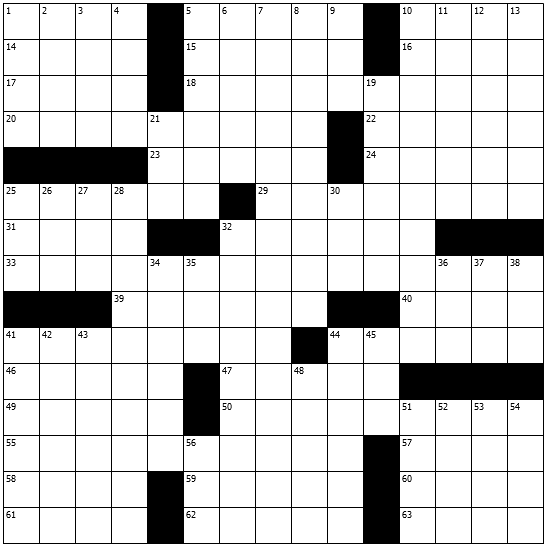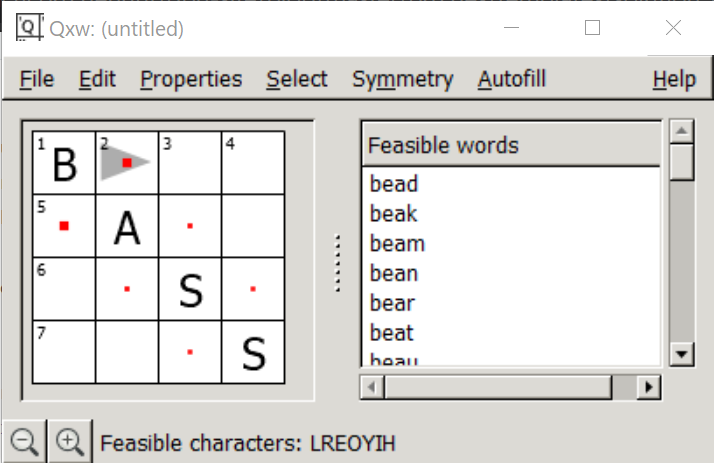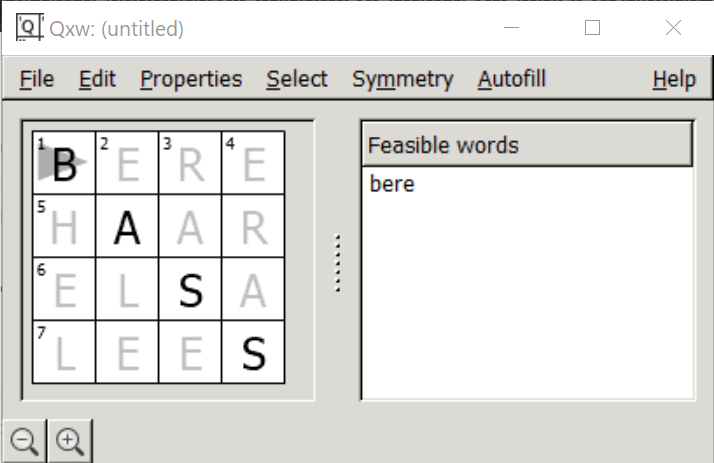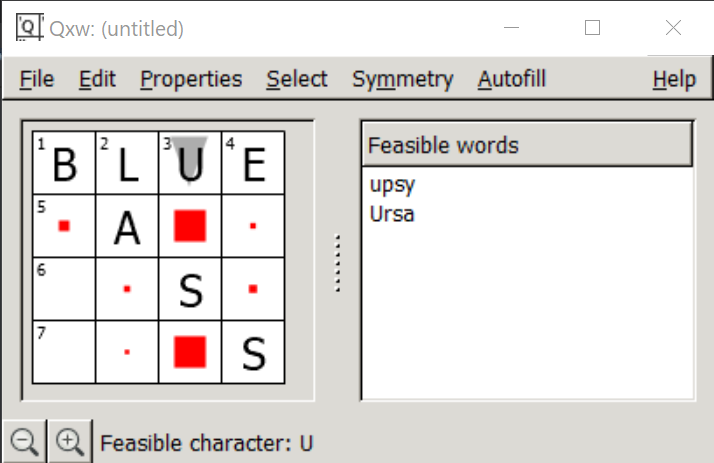
Top: An example of a conventional American-style grid (I quickly made this as an example and did not try to construct the fill). Bottom: These puzzles are typically mistaken for crosswords. Note: See @not_a_crossword for more examples
This post is written for a university assignment. It may not be kept up-to-date.

Top: An example of a conventional American-style grid (I quickly made this as an example and did not try to construct the fill). Bottom: These puzzles are typically mistaken for crosswords. Note: See @not_a_crossword for more examples
First let’s drop the word “meta.” A crossword is a puzzle with the goal of filling a grid with letters which will form words and phrases when read across or down. These Across and Down entries are filled by solving crossword clues.
The Wikipedia article provides a pretty comprehensive discussion of variations, but this post will focus on the conventions of a standard American-style grid.
The two components of a crossword are the grid and the clues. Typical American-style crosswords are 15x15 grids. Cells are shaded to denote breaks between lights, the different words and phrases in a grid. Every letter in an American-style crossword grid will be used or “checked” by both an Across and a Down light. This essentially means that there are no one-letter lights. There are typically no two-letter lights in an American-style grid, either. Furthermore, American-style grids typically have two-fold rotational symmetry (meaning you can rotate the grid 180° and the shaded cells will be in the same place).
Each light is clued with a crossword clue, which can be written with different levels of difficulty. This is where a constructor can express their personality.
A meta-crossword follows the conventions of a typical crossword puzzle but solves to a definitive final “answer.” The goal while solving a crossword is to simply fill out the grid. You’re finished once you have done that. In a meta-crossword, there may be a few remaining steps you need to figure out in order to come up with a final answer. For example, the answer can be what is read across one of the main diagonals, or from certain highlighted cells. The step is typically hinted by the title.
Making a meta-crossword consists of few main steps:
At the bare minimum, you will need a workspace. This can be paper/pencil, Google Sheets, Microsoft Paint, anything. I recommend downloading Qxw, a free crossword-writing program that will definitely help during a few steps of the writing process (See link for installation and setup instructions). I will also make references to Qxw’s commands and functions.
This might be the most difficult part for many constructors. Unlike the actual task of constructing the crossword, coming up with an idea is extremely open-ended.
Most crosswords you will find in a newspaper will have a theme. This is also true of meta-crosswords. The theme might influence certain lights, which are aptly named themers. For a meta-crossword, you will need to come up with an answer, which is inspired by the theme.
For my example, I will re-construct the 4x4 crossword, “Diagramless,” by Brian Chen. This puzzle has the answer, “BASS.”
This is often called the puzzle mechanic. Once solvers have filled out your grid, there must be a way for solvers to reach your answer. Common methods of concealment, such as reading across the main diagonal or reading highlighted cells, might not need clueing, but if your intended solution involves something more unique, you will want to suggest that somehow. Some constructors might use the title to clue the next step.
The example will have one of the most simple mechanics for getting an answer: reading the diagonal. Since solving the crossword does not require knowledge of the diagonal, hiding the answer there provides the extra step at the end.

The red squares indicate how constrained those cells are. The bigger the red quare, the fewer options you have.
From this point on, the steps are similar to that of a regular crossword. Filling out the grid is an iterative process, so you might not end up with something you are happy with the first time around. This will only touch on the main points and pitfalls. The general process is:
When you first open up Qxw, the grid is 12x12. Change this to your desired size by going to Properties > Grid Properties > Size.
These two tasks are different concepts, but their function is the same: they constrain your grid so that you can fill in the rest. An empty grid can certainly be intimidating, but you will have to make some arbitrary decisions in order to begin filling out portions of your grid. Take a look at other grids and you will begin to see certain patterns. Grids are often divided into nine areas: north, northeast, east, etc. and the center. Blocking off parts of the grid will make it easier for you to fill, but remember to try to follow conventions regarding symmetry and the lengths of lights. Grids that have fewer shaded cells are more open, but are also more difficult to fill.
I recommend that you start with one section of the grid, then work your way out.
By default in Qxw, the two-fold symmetry option is enabled. Other options are under Symmetry. To shade cells, use the Insert key. You can fill them with letters by typing in the entries.
I begin by placing the BASS down the diagonal of the grid. In a way, you are building the puzzle in the reverse order a solver would experience the puzzle. This puzzle does not require any unfilled cells. Due to conventions, the only place they could go is the top-right and bottom-left.

Autofilling the entire grid can produce bad fill. Nearly every proposed word is uncommon.

Default dictionaries are not perfect. There are a few well-known terms that can fit in the third column.
Qxw makes this process pretty simple with its Autofill feature. Select a portion of your grid by holding down the Shift key and clicking on individal cells. Then go to Autofill > Autofill selected cells. Alternatively, you can press Shift+Ctrl+G. Qxw will fill in those cells for you. You can also check the list of feasible words and select a few that you like before you autofill the rest.
Chances are, at least one of your entries will be a word you are unfamiliar with. Generally, this is undesirable and should be avoided if possible. A solver might end up getting stuck on these obscure words. A challenge is okay, but being frustrated is not very fun. You can ban words from your autofill by right-clicking a word under the Feasible Words list, then selecting Ban "word." Then, you can repeat the Autofill process until you reach a desired result. Having a few obscure words might be necessary for your grid to have any valid fill at all, so it is not the end of the world if you end up with a couple of proper nouns or abbreviations. As you gain more practice, you can work on improving your filling skills. Autofill is a tool that is very useful for new constructors and veteran constructors in tight situations. However, as you gain experience you will become more confident in manually filling more portions of your grid and decreasing obscure fill.
When you are satisfied with a section of the grid, move onto an adjacent section. Naturally, some lights will span multiple sections, influencing your later fill.
Filling is easily the most time-consuming part of construction. It involves many iterations of themer placement, cell shading, and compromises. It might take me a full day or two in order to come out with a draft I am satisfied with.
You may be tempted to Autofill the entire grid from here, but the results might not be as good as you expect. Qxw does not know if a word is common, so it might spit out obscure terms. However, it shows only one possible solution out of many, and a persevering constructor will find the best solution.
Say I want the topmost across entry to be BLUE. Qxw only suggests two options for the third down entry; neither of which are that great. However, keep in mind that this is a limitation of the dictionary that comes with Qxw. For example, USSR, an oft-used term in history, can fit there and happens to be omited from the default dictionary. In most cases, a constructor will have to manually find entries in order to satisfy their standard for “good” fill.

After a few iterations of choosing words and evaluating the fill, we can land on a decent grid.
There is a big jump from the last step to this one. This step typically comes after you filled in every single cell in your grid and are satisfied with it. As I mentioned before, filling is probably the most time-consuming part. However, once you are finished, you can begin the final part.
Writing clues can be as easy as it sounds. You are simply trying to provide a fun way for solvers to fill in the entires. However, clues are where the constructor’s personality can really shine through, so it is up to you how you want to approach it. Many constructors will try to reference their personal interests while writing clues, or try to include a few puns and clever clues. There is not much to explicitly say in this step, but there are a few conventions:
New York Times’ How to Solve a Crossword Puzzle provides a more in-depth list of conventions. If you solve a lot of crosswords, you will begin to recognize conventions that you should follow if you end up writing them.
This grid only has eight words, so writing the clues will be pretty simple and I will omit details for this.
Now that you are done, what’s next? Well, you should have someone test-solve your puzzle. This is similar to the revision process, but specifically involves asking someone you solve your puzzle. When writing, you might have imagined some clues were easy for you, but they may not be easy for everyone. Furthermore, your meta-crossword mechanic might be too difficult and require additional clueing. Like any revision process, test-solving can help you iron out any undesired issues you missed. You certainly do not want your grid to have a misspelled word in it. Throughout the test-solving process, you might have to reconstruct large portions of your grid or compromise on some of your original ideas. However, you should ideally come out of this process with a more complete product.
Meta-crosswords are relatively unknown to the general public, but can provide an extra challenge to veteran crossword solvers. Constructing one is not too different from constructing a typical crossword, but it might require some more up-front creativity. Nowadays, there are tools, such as Qxw, to make the constructing process easier for beginners. If you are someone who already enjoys solving crosswords, then I would recommend you try your hand at constructing a crossword or meta-crossword.
If you have made it this far, congratulations! With many creative projects, make sure to share your creation with your friends. There’s a good chance they’ve never seen anything like this before.